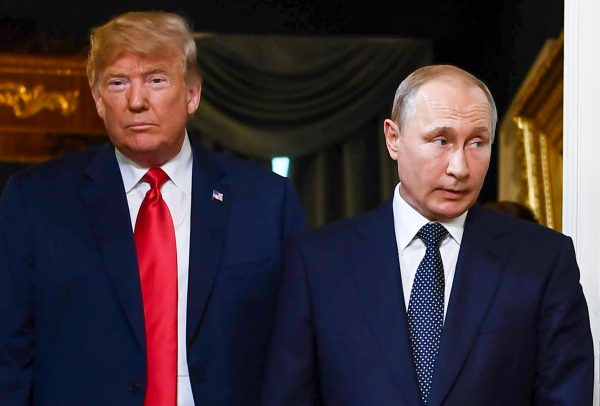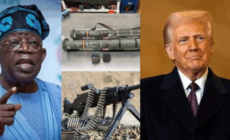US pulls out of nuclear treaty with Russia
- Posted on
- Comment
The US is formally withdrawing from a nuclear treaty with Russia, raising fears of a new arms race.
The Intermediate-Range Nuclear Forces Treaty (INF) was signed by US President Ronald Reagan and Soviet leader Mikhail Gorbachev in 1987.
It banned missiles with ranges between 500 and 5,500 km (310-3,400 miles).
But earlier this year the US and Nato accused Russia of violating the pact by deploying a new type of cruise missile, which Moscow has denied.
The Americans said they had evidence that Russia had deployed a number of 9M729 missiles – known to Nato as SSC-8. This accusation was then put to Washington’s Nato allies, which all backed the US claim.
“Russia is solely responsible for the treaty’s demise,” Secretary of State Mike Pompeo said in a statement on Friday.
“With the full support of our Nato allies, the United States has determined Russia to be in material breach of the treaty, and has subsequently suspended our obligations under the treaty,” he added.
Russia’s foreign ministry confirmed the INF treaty is “formally dead” in a statement carried by state-run Ria Novosti news agency.
President Donald Trump announced in February that the US would withdraw from the pact if Russia didn’t come into compliance, and set the deadline for 2 August.
Russian President Vladimir Putin suspended his country’s own obligations to the treaty shortly afterwards.
What are the risks?
“An invaluable brake on nuclear war” was being lost, warned UN Secretary General Antonio Guterres.
“This will likely heighten, not reduce, the threat posed by ballistic missiles,” he added, urging all parties to “seek agreement on a new common path for international arms control”.
Analysts fear that the collapse of the historic agreement could lead to a new arms race between the US, Russia and China.
“Now that the treaty is over, we will see the development and deployment of new weapons,” Pavel Felgenhauer, a Russian military analyst, told AFP news agency. “Russia is already ready.”
Last month, Nato Secretary General Jens Stoltenberg told the BBC that the Russian missiles – which he said were in “clear violation of the treaty” – were nuclear-capable, mobile, very hard to detect, and could reach European cities within minutes.
“This is serious,” he added. “The INF treaty has been a cornerstone in arms control for decades, and now we see the demise of the treaty.”
He added that there had been “no signs whatsoever” that Russia would comply with the agreement – and that “we have to be prepared for a world without the INF treaty and with more Russian missiles”.
Mr Stoltenberg also said that any decision by Nato about how exactly to respond would come after the deadline.
Nato has no plan to deploy land-based nuclear missiles of its own in Europe, he said, but conventional air and missile defence, new exercises and readiness of forces, and new arms control initiatives could all form part of the response.
What is the Intermediate-Range Nuclear Forces (INF) treaty?
- Signed by the US and the USSR in 1987, the arms control deal banned all nuclear and non-nuclear missiles with short and medium ranges, except sea-launched weapons
- The US had been concerned by the Soviet deployment of the SS-20 missile system in 1979 and responded by placing Pershing and cruise missiles in Europe – sparking widespread protests
- By 1991, nearly 2,700 missiles had been destroyed
- The two countries were allowed to inspect each other’s installations

The demise of the INF treaty – the only disarmament agreement ever to eliminate a whole category of nuclear weapons – represents a significant setback for advocates of arms control.
That it comes at a time when the US is increasingly concerned by the threat from what it sees as a resurgent Russia is doubly unsettling.
Neither Moscow nor Washington appears to value such treaties.
The most important agreement of the old Cold War years – the New Start treaty – that limits long-range nuclear weapons is set to expire in February 2021. Its survival is far from certain.
The paradox is that arms control appeared unimportant after the collapse of the Soviet Union when tensions were low.
Now that they are mounting again, disarmament agreements could have an important part to play in maintaining stability.
Instead arms control is in crisis, just when dangerous new weapons technologies (involving artificial intelligence and high-speed “hypersonic” missiles) are being developed.
Where did things go wrong?
In 2007, Russian President Vladimir Putin declared the treaty no longer served Russia’s interests.
That happened after US President George W Bush, in 2002, pulled the US out of the Anti-Ballistic Missile Treaty, which banned weapons designed to counter ballistic nuclear missiles.
In 2014, then US President Barack Obama accused Russia of breaching the INF Treaty after it allegedly tested a ground-launched cruise missile.
He reportedly chose not to withdraw from the treaty under pressure from European leaders, who said such a move could restart an arms race.
“Allies have concluded that Russia has developed and fielded a missile system, the 9M729, which violates the INF Treaty and poses significant risks to Euro-Atlantic security,” a statement from Nato foreign ministers read.
The statement said the member nations “strongly support” the US claim that Russia is in breach of the pact, and called on Moscow to “return urgently to full and verifiable compliance”.
Russia denied the accusation and President Putin said it was a pretext for the US to leave the pact.
Amid worsening ties between Washington and Moscow, Turkey last month received the first parts of a Russian S-400 missile defence system despite opposition from the US.
The US has warned that Turkey cannot have both the S-400 anti-aircraft defence system and US F-35 fighter jets.
Turkey and the US are Nato allies but Turkey has also been establishing closer links with Russia.
-BBC











 (Selorm) |
(Selorm) |  (Nana Kwesi)
(Nana Kwesi)